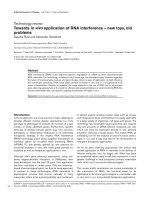Basic Principles in Clinical Application Of Multileaf Collimator
Bạn đang xem bản rút gọn của tài liệu. Xem và tải ngay bản đầy đủ của tài liệu tại đây (698.07 KB, 43 trang )
VIETNAM NATIONAL UNIVERSITY, HA NOI
VNU UNIVERSITY OF SCIENCE
FACULTY OF PHYSICS
----------------
Nguyen Ngoc Trang
BASIC PRINCIPLES IN CLINICAL APPLICATION OF
MULTILEAF COLLIMATOR
Submitted in partial fulfillment of the requirements for the degree of Bachelor of
Science in Physics
(International Standard Program)
Supervisor: Nguyen Xuan Ku, MSc
HA NOI June, 2017
ACKNOWLEDGMENT
This thesis would not have been possible without the support of many
individuals who generously shared their wisdom and time with me. First of all, I
would like to express my gratidude to Master Nguyen Xuan Ku, my thesis
committee chairman. His input and guidance proved invaluable in the development
of my ideas into a successful thesis project. This thesis truly could not have been
completed without him.
I would also like to thank Msc. Kieu Thi Hong for this suggestions and for
helping me learn along the way. I am very grateful to all of the staff of at Military
Central Hospital 108 and Phu Tho Hospital for sharing their knowledge with me
and for always helping me find the answers to my endless questions.
Finally, I would like to thank my friends and my family for their great
support. I could not have done this without them. The biggest thank you goes to my
roomates who never left my side and through his encouragement enabled me to
keep going.
Student,
Nguyen Ngoc Trang
LIST OF ABBREVIATION
2D
Two Dimensions
3D
Three Dimensions
3-DRTP
Three dimensions radiation treatment planning
BEV
Beam’s Eye View
DRR
Digitally Reconstructed Radiograph
DVHs
Dose volume histograms
GE
General Electric
HVL
Half - value Layer
IMRT
Intensity Modulated Radiation Therapy
LCD
Liquid crystal display
miniMLCs
Miniature Multileaf Collimator
MLC
Multileaf Collimator
MLCPPS
Multileaf collimator prescription preparation system
MU
Moniter Unit
PTV
Planning Target Volume
QA
Quanlity Assurance
R&V
Recorded and Verify
SAD
Source-axis distance
SCD
Source-collimator distance
TPS
Treatment planning system
TABLE OF CONTENTS
INTRODUCTION ----------------------------------------------------------------------------1
CHAPTER 1: MULTILEAF COLLIMATOR DESIGN --------------------------------3
1.1 Leaf Design -----------------------------------------------------------------------------3
1.2 Summary of Configurations ----------------------------------------------------------4
1.2.1 Upper Jaw Replacement ---------------------------------------------------------4
1.2.2 Lower Jaw Replacement ---------------------------------------------------------5
1.2.3 Third Level Configuration -------------------------------------------------------7
1.2.4 Field-Shaping Limitations -------------------------------------------------------7
1.3 Attenuation -----------------------------------------------------------------------------9
1.3.1 Material and Properties ----------------------------------------------------------9
1.3.2 Transmission Requirements ---------------------------------------------------- 10
1.4 Interleaf Transmission -------------------------------------------------------------- 10
1.5 Leaf End Shape ---------------------------------------------------------------------- 12
1.6 MLC Control Features -------------------------------------------------------------- 14
1.7 Leaf Position Detection ------------------------------------------------------------- 14
1.7.1 Linear Switches ------------------------------------------------------------------ 14
1.7.2 Linear Encoder ------------------------------------------------------------------ 14
1.7.3 Video-optical system ------------------------------------------------------------ 14
1.7.4 Driving Mechanism ------------------------------------------------------------- 15
1.7.5 Calibration of MLC Leaf position--------------------------------------------- 15
1.7.6 The Control of Back-up Jaws -------------------------------------------------- 15
1.8 Summary of MLC Configurations ------------------------------------------------- 16
1.9 Nonconventional MLCs ------------------------------------------------------------ 16
1.10 Computer System Configurations for MLC Leaf Prescription --------------- 18
CHAPTER 2: MONITOR UNIT CACULATIONS ----------------------------------- 19
2.1 The Physics of In-Air Photon Scatter --------------------------------------------- 19
2.2 MLC replaces the Upper Jaws in the Secondary Collimator ------------------- 19
2.3 MLC replaces the Lower Jaws in the Secondary Collimator ------------------ 20
2.4 MLC as Tertiary Collimator -------------------------------------------------------- 21
CHAPTER 3: MLC ACCEPTANCE TESTING, COMMISSIONING, AND
SAFETY ASSESSMENT ----------------------------------------------------------------- 22
3.1 Acceptance Testing and Commissioning ----------------------------------------- 22
3.1.1 Mechanical Acceptance and Commissioning Tests ------------------------- 22
3.1.2 Leaf Positioning with Collimator Rotation ---------------------------------- 22
3.1.3 Leaf Positioning with Gantry Rotation --------------------------------------- 23
3.1.4 Coincidence of Light Field and X-ray Field --------------------------------- 23
3.1.5 Leaf Transmission --------------------------------------------------------------- 24
3.1.6 Penumbra ------------------------------------------------------------------------ 25
3.1.7 Dosimetric Parameters --------------------------------------------------------- 25
3.1.8 Interlocks and File Transfer --------------------------------------------------- 26
3.2 Safety Assessment ------------------------------------------------------------------- 26
CHAPTER 4: QUALITY ASSURANCE (QA) ---------------------------------------- 27
4.1 Port film/Light Field Checks ------------------------------------------------------- 27
4.2 Record and Verify (R&V) Computer Checks ------------------------------------ 27
CHAPTER 5: CLINICAL APPLICATIONS ------------------------------------------- 29
5.1 Leaf Placement Strategies ---------------------------------------------------------- 29
5.1.1 Definition of Target Area ------------------------------------------------------ 29
5.1.2 Optimization of MLC Conformation ------------------------------------------ 30
5.2 Techniques to Determining Leaf Positions --------------------------------------- 31
5.3 Optimization of Collimator Rotation ---------------------------------------------- 32
5.4 Intensity Modulated Radiotherapy (IMRT) with MLC ------------------------- 33
CONCLUSION ----------------------------------------------------------------------------- 35
REFERENCES------------------------------------------------------------------------------ 36
LIST OF FIGURE
Figure 1: Multileaf Collimator of Varian Millenium MLC120. ................................ 1
Figure 2: MLC leaf design illustrating the leaf terminology. .................................... 3
Figure 3: MLC and standard collimators positions in treatment head use in third
level configurations. The field dimensions in the plane at isocenter are indicated. .. 4
Figure 4: Schematic diagram of the Philips MLC. The upper jaw is replaced by the
MLC leaves. ............................................................................................................... 5
Figure 5: Schematic diagram of the General Electric Medical Systems MLC that
replaces the lower jaws. ............................................................................................. 6
Figure 6: A comparison of the leaf travel configurations of commercially available
MLCs. The maximum leaf extensions are compared to a 40X40 cm maximum field
size. ............................................................................................................................. 8
Figure 7: End view of the Siemens MLC showing the truncated pie shape of the
leaves as well as the leaf side shape to reduce interleaf transmission. .................... 11
Figure 8: Illustration of different leakage paths between leaves and the effect of leaf
cross-section shape on penumbra along the side of an MLC leaf............................ 12
Figure 9: Rounded leaf ends and their influence on penumbra based on the position
in the field. SAD is the distance from the source to the isocenter and SCD is the
distance from the source to the center of the leaf. R is radius of curvature of the leaf
end. ........................................................................................................................... 13
Figure 10: Illustration of video-optical method to determining leaf position. ........ 15
Figure 11: Schematic of MLC prescription preparation workstation and it
relationship to other parts of the treatment planning and delivery system employing
MLCs. ....................................................................................................................... 18
Figure 12: Three leaf coverage strategies in relation to the PTV, (a)”out-of-field
strategy; (b)”in-field” strategy, (c)”cross-boundary” strategy. ................................ 30
Figure 13: IMRT technique with use of MLC. ........................................................ 33
INTRODUCTION
Basic goal of radiotherapy treatment is the irradiation of a target volume
while minimizing the amount of radiation absorbed in healthy tissue. Shaping the
beam is an important way of minimizing the absorbed dose in healthy tissue and
critical structures. Conventional collimator jaws are used for shaping a rectangular
treatment field; but, as usually treatment volume is not rectangular, additional
shaping is required. On a linear accelerator, lead blocks or individually made
Cerrobend blocks are attached onto the treatment head under standard collimating
system. Another option is the use of multileaf collimator (MLC). MLC were
developed and have become a standard feature of new linear accelerator for
radiation therapy. They consist of two banks of 40 to 160 opposing movable
leaves or shield, each leaf under individual motor control (see Figure 1). The
leaves are positioned to form the field or aperture shape of the treatment beam.
Each leaf blocks a portion of radiation beam.
Figure 1: Multileaf Collimator of Varian Millenium MLC120.
The hazards involved with lead-alloy blocks are eliminated. Shielding
preparation time and storage space is reduced. As the positioning of the leaves is
1
under computer control, the field apertures can be set remotely from outside the
treatment room. Thus treatment times can be reduced, and treatment with larger
numbers of fields becomes feasible. The treatment aperture shape can also be
easily modified if necessary without having to manufacture new blocks. Intensity
modulated radiotherapy (IMRT), the therapy of the future, is based on the
dynamic use of MLC.
The aim of this thesis is to provide basic information and to state
fundamental concepts needed to implement the use of a multileaf collimator
(MLC) in the conventional clinical setting. MLCs are available from all the major
therapy accelerator manufacturers. The use of MLCs to replace conventional
field-shaping techniques is not in itself expected to improve the local control of
malignancy. The rationale for using MLCs in conventional radiation oncology is
to improve the efficiency of treatment delivery. Thus, the intent of this thesis is to
assist medical physicists, dosimetrists, and radiation oncologists with the
acquisition, testing, commissioning, daily use, and quality assurance (QA) of
MLCs in order to realize increased efficiency of utilization of therapy facilities.
There are three basic applications of the MLC. The first application is to
replace conventional blocking. A second function of the MLC is an extension of
the first. One variant of conformal therapy entails continuously adjusting the field
shape to match the beam’s eye view (BEV) projection of a planning target volume
(PTV) during an arc rotation of the x-ray beam (Takahashi 1965). The third
application is the use of the MLC to achieve beam-intensity modulation. These
latter two applications of the MLC are advanced forms of conformal therapy and
will not be considered in detail in this thesis.
The content of the thesis includes five chapters:
Chapter 1: Multileaf Collimator Design
Chapter 2: Monitor Unit Calculations
Chapter 3: MLC Aceptance Testing, Commissioning and Safety
Assessment
Chapter 4: Quanlity Assurance (QA)
Chapter 5: Clinical Applications
2
CHAPTER 1: MULTILEAF COLLIMATOR DESIGN
1.1 Leaf Design
An illustration of the MLC leaf design is shown in Figure 2. The width of a
leaf will be the small dimension of the leaf perpendicular to the direction of
propagation of the x-ray beam and perpendicular to the direction of motion of the
leaf. The width of the leaf determines the resolution of the field shape. The length
of the leaf shall refer to the leaf dimension parallel to the direction of leaf motion.
The surface of the leaf inserted into the field along this dimension is leaf end. The
surfaces is contact with adjacent leaves are leaf side. The height of the leaf inserted
Figure 2: . MLC leaf design illustrating the leaf terminology.
into the field along this dimension is the leaf end. The surfaces in contact with
adjacent leaves are the leaf sides. The leaf sides are divergent to the source to
minimise penumbra. The height of the leaf shall refer to the dimension of the leaf
along the direction of propagation of the primary x-ray beam. The leaf height
extends from the top of the leaf near the x-ray source to the bottom of the leaf
nearest the isocenter. The height of the leaf determines its attenuation properties.
The reduction of dose through the full height of the leaf will be referred to as the
leaf transmission. The reduction of dose measured along a line passing between
leaf sides will be referred to as interleaf transmission, and the reduction of dose
3
measured along a ray passing between the ends of opposed leaves in their most
closed position will be referred to as the leaf end transmission.
Figure 3: MLC and standard collimators positions in treatment head use in third level
configurations. The field dimensions in the plane at isocenter are indicated.
1.2 Summary of Configurations
MLC configurations may be categorized as to whether they are total or
partial replacements of upper jaws, lower jaws or as tertiary collimator
configurations.
1.2.1 Upper Jaw Replacement
This configuration entails splitting the upper jaw into a set of leaves.
Currently the Elekta (formerly Philips) MLC is designed in this manner (see Figure
4). In the Philips design, the MLC leaves move in the y-direction (parallel to the
axis of rotation of the gantry). A “back-up” collimator located beneath the leaves
and above the lower jaws augments the attenuation provided by the individual
leaves. The back-up diaphragm is essentially a thin upper jaw that can be set to
4
follow the leaves if they are being ganged together to form a straight edge or else
set to the position of the outermost leaf if the leaves are forming a shape.
The primary advantage of the upper jaw replacement configuration is that the
range of motion of the leaves required to traverse the collimated field width is
smaller, allowing for a shorter leaf length and therefore a more compact treatment
head diameter. The disadvantage of having the MLC leaves so far from the
accelerator isocenter is that the leaf width must be somewhat smaller and the
tolerances on the dimensions of the leaves as well as the leaf travel must be tighter
than for other configurations. Leave of this collimator have total travel distance
32.5 cm, which mean can extend 12.5 cm across the center line.
Figure 4: Schematic diagram of the Philips MLC. The upper jaw is replaced by the
MLC leaves.
1.2.2 Lower Jaw Replacement
The lower jaws can be split into a set of leaves as well. The Scanditronix
Racetrack Microtron, as well as the Siemens and the General Electric (GE) MLC
5
options use this configuration (see Figure 5). The GE MLC system is no longer
being sold. In both the Scanditronix design and the Siemens design, the leaf ends
are straight and are focused on the x-ray source. All leaves can travel from the full
open position (projecting to a field half-width of 20 cm) to 10 cm across the central
axis. All the leaves are independently controlled and travel with a speed of up to
1.5 cm/sec. The leaves may be manually positioned with an MLC hand control and
these leaf-settings can be uploaded to an information management Record and
Verify (R&V) system. The leaf ends as well as the leaf sides match the beam
divergence, making the configuration double-focused. The GE configuration uses
curved leaf ends and contains a secondary “trimmer” similar to the Elekta back-up
diaphragm. Trimmer above the upper jaws is used to refine the penumbra at the leaf
ends. However, this trimmer is located above the upper jaws in the GE design (see
Figure 5).
Figure 5: Schematic diagram of the General Electric Medical Systems MLC that
replaces the lower jaws.
6
1.2.3 Third Level Configuration
MLC can be positioned just below the level of the standard upper and lower
adjustable jaws (Figure 3). This design is used by Varian and was chosen to avoid
lengthy downtime in the event of a MLC system malfunction. Using this approach,
it is possible to move leaves manually out of the field should a failure occur.
Treatment can continue after replacement cerrobend blocks have been fashioned.
The major disadvantage of placing the MLC below the standard jaw system is the
added bulk. Clearance to the mechanical isocenter is an additional, but minor,
problem. Clearance for the Varian MLC depends on the exact combination of beam
modifiers used for a particular treatment situation. When the MLC is fitted and a
block support tray is added for additional field shaping, clearance to the isocenter is
the same as the non-MLC treatment head. Physical wedges are added below the
blocks, and decrease clearance to some degree. Using the MLC without
supplemental alloy blocks allows removal of the entire block support system and
increases clearance. In this case, physical wedges are mounted on the face of the
treatment head and clearance is usually acceptable. Of course, there is no change in
clearance when the dynamic wedge feature is used. In addition to the question of
clearance, the diameter of the head at the level of the secondary and tertiary
collimator system is increased. Moving the MLC farther from the x-ray target
requires an increase in the size of the leaves and a longer travel distance to move
from one side of the field to the other. The end result is that a tertiary system
decreases the collision free zone. For example, if a blocking tray holder is retained,
patients whose treatment positions call for their elbows to extend laterally, such as
in treatment of breast cancer, may not clear unless the blocking tray holder is
removed. The leaves in the Varian collimator travel on a carriage that serves to
extend their movement across the field. However, the distance between the most
extended leaf and the most retracted leaf on the same side can only be 14.5 cm.
1.2.4 Field-Shaping Limitations
The field-shape limitations of the various collimators are shown in Figure 6.
The top panel illustrates the field-shaping limits for the Siemens and Elekta
(Philips) collimators. A representation of the Siemens leaf extension is shown at the
top of the panel. Starting with the jaws and all the leaves positioned to define a
7
40×40 cm field, the four leaves at the top of this diagram have been moved into the
maximum square field opening. The leaf at the top of the field is inserted to its
maximum extension. It is extended 20 cm to the center of the field and an
additional 10 cm across the centerline. This gives a maximum leaf travel for this
collimator system of 30 cm. This is similar to the General Electric Medical Systems
collimator illustrated in the top portion of the bottom panel in Figure 6. The
movement of the Elekta (Philips) collimator leaves is shown in the lower portion of
the top panel of Figure 6. In this case, the leaves can extend 12.5 cm across the
field centerline. The total travel distance for this system is 32.5 cm.
Figure 6: A comparison of the leaf travel configurations of commercially available
MLCs. The maximum leaf extensions are compared to a 40X40 cm maximum field size.
The Varian collimator uses a different design. The leaves in the Varian
collimator travel on a carriage to extend their movement across the field. However,
8
the distance between the most extended leaf and the most retracted leaf on the same
side can only be 14.5 cm. This means that it is not possible to obtain extensions
similar to those shown in the other portions of Figure 6. The possible extensions of
the Varian collimator are illustrated in the bottom portion of the bottom panel.
Extending the leaves out to the field center is not possible when large fields are
used. This limitation is most severe for large field widths. This can be illustrated by
a medium field size of 20-cm width that is symmetric relative to the field center. In
this case, the entire carriage can be moved so that the leaves can extend 4.5 cm (the
14.5-cm limit minus the 10-cm half field width) over the field center. For a similar
field, the leaves of the other systems could be extended entirely across the width of
the 20-cm field. However, when an asymmetric jaw is used to block half of the
field (shown in the right side of the bottom of the bottom panel), the Varian
carriage can be moved to the field center and a leaf can be extended 14.5 cm
beyond the field center, further than any of the other systems. For single field block
replacement, the Varian tertiary configuration is more limited than the other
systems. On the other hand, this configuration lends itself to broader applications of
intensity modulation.
1.3 Attenuation
The leaves of the MLC must provide an acceptable degree of attenuation,
must be shaped optimally to provide field shaping when working together
throughout a range of field sizes, and must be integrated with the rest of the
collimation system. Selecting the materials and designing the leaf shapes and
positioning apparatus to achieve these ends is an engineering challenge.
1.3.1 Material and Properties
Tungsten alloy is the material of choice for leaf construction because it has
one of the highest densities of any metal. Tungsten alloys are also hard, readily
machinable, and reasonably inexpensive. An additional advantage is that they have
low coefficients of expansion, so that parts can be machined to exacting tolerances,
an important consideration with regard to interleaf separations. Pure tungsten has a
density of 19.3 g/cm3, but the alloys have densities that range from 17.0 to 18.5
g/cm3, with varying admixtures of nickel, iron, and copper to improve
9
machinability. Pure tungsten is very brittle and the machinability of tungsten alloy
improves with decreasing tungsten content.
1.3.2 Transmission Requirements
When the upper or lower jaws are replaced with leaves, the transmission
requirements are the same as those of a set of collimating jaws. The requirements
for the tertiary arrangement are somewhat different. When the adjustable photon
jaws of the linac are used to set the overall size of the field, it is only necessary that
the leaves of the tertiary MLC attenuate the primary beam to the same extent as
customized blocks, i.e., <5% or between 4 and 5 HVL (half-value layer). However,
since there is transmission between the leaves, the transmission through the leaves
should be lower than this to ensure that the overall transmission meets this
criterion. This criterion is met by a thickness of approximately 5 cm of tungsten
alloy. If one wishes to reduce the transmission by, say, a further factor of 5 to 1%,
this would require an additional thickness of approximately 2.5-cm. Thus, for the
tertiary MLC one has to trade-off in-field attenuation against space between the
collimator head and the couch.
1.4 Interleaf Transmission
The cross-sectional shapes of the leaves are quite complex and present a
challenge to the manufacturer. The two important factors which determine this
shape are that the leaves (1) are focusing in the plane orthogonal to their travel and
therefore have to incorporate divergence and (2) have to overlap their neighbors to
minimize interleaf transmission. The first requirement dictates a truncated pie
shape while the second modifies the sides of the leaves (see Figure 7). The simplest
way to overlap the leaves is to stagger the leaves midway along their height; but for
mechanical integrity and ease of movement of one leaf relative to its neighbor,
more complex arrangements have generally been found to be necessary. Most leaf
designs have a profile that steps out and then steps back again.
10
Figure 7: End view of the Siemens MLC showing the truncated pie shape of the leaves
as well as the leaf side shape to reduce interleaf transmission.
There are two situations to consider for interleaf transmission: (1) between
the sides of adjacent leaves and (2) between the ends of the leaves. An idealized
analysis of the fluence transmission at the leaf sides has been made (Jordan and
Williams 1994). Figure 8 provides a schematic for discussion. This figure depicts
leaves viewed end-on so that the fluence passing tangent to the sides can be
analyzed. In Figure 8 the leaf side is simplified as a step function. A ray line along
track a in Figure 8 passes through the entire height of the leaf and undergoes full
attenuation. A ray passing along b is attenuated by about one-half of the leaf
thickness. The ray line along c passes through the side offset of both neighboring
leaves and undergoes nearly full attenuation. The resulting idealized interleaf
fluence profile is indicated at the bottom of Figure 8.
In practice, the theoretical valley in the center of the leakage profile is never
detected. Although the overall pitch of the leaf pattern may be 1 cm, the profile of a
strip irradiated by the retraction of a single leaf is somewhat wider (W′ in Figure 8),
and has a penumbra broadened by the leaf side design, being governed by
(W′ − W)/2. In practice, the depths of the leaf side steps are only fractions of a
millimeter, and so the broadening is quite small.
11
Figure 8: Illustration of different leakage paths between leaves and the effect of leaf
cross-section shape on penumbra along the side of an MLC leaf.
1.5 Leaf End Shape
Adjustable secondary collimator systems have for some time been designed
to follow the beam divergence as the field opens and closes. Collimators of this
type are referred to as “focused.” Various approaches have been used to keep the
face of each collimator aligned parallel to the primary fluence for all field sizes.
Most commonly, the collimator moves along the circumference of a circle that is
centered at the x-ray target of the linac such that the end of the collimator is always
tangent to the radius of the circle. Alternatively, the movement of the collimators
can be restricted to a single plane perpendicular to the beam central axis, and a
small independent portion of the front face of each jaw tilted as the position of the
collimator changes so that agreement with beam divergence is maintained. This is
the approach used on the current generation of Siemens accelerators. Either design
is fairly easily implemented when only four individual jaws are involved. However,
they are hard to apply to the significantly more complex situation where a large
number of individual collimator leaves are moved independently. For this reason, at
least two of the early commercially available MLC systems (Philips and Varian)
have used a simpler approach. This design restricts the movement of the leaves to a
12
single plane, and relies on shaping of the leaf face to produce an acceptable
penumbra. The idea of shaping a collimator or leaf end to control penumbra width
is more than 10 years old (Maleki and Kijewski 1983). This design is most easily
visualized as a rounded end that is part of a circle (see Figure 9).
Figure 9: Rounded leaf ends and their influence on penumbra based on the position in
the field. SAD is the distance from the source to the isocenter and SCD is the distance
from the source to the center of the leaf. R is radius of curvature of the leaf end.
There are two concerns over collimation with nonfocused leaf ends. First, the
penumbra width can be larger than the penumbra generated by a focused or
divergent edge. Second, the penumbra width might change as a function of the
distance of the leaf end from the field midline. Attenuation of the edge of the field
occurs in the rounded end along chords of the circle. These chords rotate around the
end of the leaf as the leaf is moved through its range of travel. Since the chords all
have approximately the same length, the attenuation just outside the field is always
the same, and the penumbra is of the same width, although in principle it is
somewhat greater than for a focused leaf. Different philosophies have been used to
determine the radius of curvature for the leaf end, and flat sections have been added
by some manufacturers (Galvin et al. 1992).
13
1.6 MLC Control Features
MLCs produced by different manufacturers employ different mechanisms for
moving the leaves accurately to their prescribed positions. The task of moving a
leaf to the correct position normally involves the following procedures: (1) the
detection of the position of leaf; (2) the leaf control logic; and (3) the mechanism
that moves the leaf to position. Position sensors mechanically linked to collimators
include video-optical systems, and linear encoders. For two-dimensional (2-D) field
shaping, the controlling decision may involve dosimetry compensation, leaf speed
settings, etc. The mechanisms that are used to drive the leaves include digital and
analog motors driving individual leaves.
1.7 Leaf Position Detection
Leaf positions must be detected in real-time to achieve safe and reliable
position control. Depending on the type of multileaf system, the complexity and
mechanism of leaf position detection varies. Linear encoders and video optical
systems are most commonly used for detection. The following describes the
mechanisms commonly used in existing commercial systems.
1.7.1 Linear Switches
Limit switches are used in bi-state MLCs such as that developed by NOMOS
Corporation, Inc. The open or closed state can be detected depending on which
switch is turned on by the leaf.
1.7.2 Linear Encoder
We can use many different linear encoders, but for detection of leaf positions
in MLC systems high precision potentiometers are commonly used. These
potentiometers can detect positions of any individual leaf in the system. For safe
work two potentiometers with correlated readings are used in this system.
1.7.3 Video-optical system
This system of detection uses the same light source for patient positioning
and for leaf position recognition. A retro-reflector is mounted near the end of each
leaf, and the light is reflected from it back to the camera. The obtained signal is
digitized and processed with an image processor in the MLC controller.
14
Figure 10: Illustration of video-optical method to determining leaf position.
1.7.4 Driving Mechanism
Each leaf has a small motor, which drives it precisely in the directions from
the main unit. These rotations must than be translated to linear motion which
moves the leaf to the desired position. Linear screw bars are normally used to
translate rotations to linear motion. The speed of the leaf travel varies between 0.2
mm/s to as high as 50 mm/s, depending on the design.
1.7.5 Calibration of MLC Leaf position
An important procedure to ensure accurate leaf positioning is the calibration
of leaf positions. Through the calibration, the measured signals, such as voltages
from the potentiometers or pixel numbers from a solid-state camera, and the actual
leaf positions establish a one-to-one relationship. Periodic checking and
recalibration are also needed to ensure the integrity of the controlling system.
1.7.6 The Control of Back-up Jaws
In some MLCs, the back-up jaws are designed as part of the MLC system
and are controlled by the MLC controller. In other systems, the jaws are controlled
separately by the linear accelerator controller. When components of the upper or
lower jaws are required to achieve acceptable leakage through the MLC portion of
15
the collimation system, the jaws must be coordinated with the leaves to minimize
the leaf transmission and interleaf leakage, and to achieve better penumbra.
Minimal leaf transmission and interleaf leakage is achieved by setting the
jaws such that they at least circumscribe the irregular field formed by the leaves.
For many clinical applications, it may be desired to use the jaw to provide a
considerable portion of the field circumference. In these cases forcing the jaws to
circumscribe the MLC outline is not desired. In the direction of leaf motion, the
jaws can be positioned to sharpen the penumbra and partially compensate for
affected curved leaf ends. In the direction perpendicular to that of leaf motion, the
jaws should always shape a segment of the beam edge.
1.8 Summary of MLC Configurations
The MLC configurations generally available at the time of the preparation of
this report are summarized in Table 1. Table 1 lists characteristics of five particular
treatment machines with MLCs. The Varian C2100C has a third-level MLC
configuration and also has the option of placing the wedges above or below the
block tray. The Elekta (Philips) SL Asymmetric series has standard or short block
tray options, and contains an internal wedge. The Scanditronix Microtron has
internal wedges at different distances, and essentially no block tray.
1.9 Nonconventional MLCs
For small fields such as those used for brain tumors or boost fields in the
head and neck, finer resolution of the field margins may be required than for larger
PTVs prescribed around gross tumor volumes for which wider margins are required
because of inherent organ motion. Several miniature multileaf collimators
(miniMLCs) have been developed to be used for these cases (Shiu et al. 1997).
Irregularly shaped brain tumors present challenges for treatment using conventional
radiosurgical techniques. Treatment of multiple isocenters by stereotactic
teletherapy (or multiple isocenters used by linac radiosurgery) often results in high
dose inhomogeneities, with which complications have been associated. Dynamic
field shaping that produces the prescribed dose conformal to the target volume is
one strategy that may be used to reduce dose to normal brain tissue while
minimizing the dose inhomogeneity within the target volume.
16
Table 1. Summary of MLC Configurations for Various Treatment Machines
Elekta
Source To
Siemens
General
Varian
(Philips)
Scandatronix
Digital
Electric
CL2100C
SL
Microtron
Mevatron
Saturne 43
Bottom of
upper jaw
35.7 cm
42.6 cm
47.5 cm
27.8 cm
33.6 cm
Bottom of
lower jaw
44.4 cm
50.9 cm
---
35.9 cm
N/A
Leaf bottom
53.6 cm
37.3 cm
67.5 cm
---
45.7 cm
Block tray
65.4 cm
67.2 cm
70.6 cm
56.0 cm
61.0 cm
Compensating
filter tray
69.2 cm
N/A
N/A
N/A
50.5 cm
N/A
22.9 cm
22.0 cm (45o)
Top of Internal
Wedge
N/A
18.6 cm
Gantry housing
57.9 cm
52.9 cm
71.0 cm
***43.0 cm
50.0 cm
Leaf thickness
*5.53 cm
7.5 cm
7.5 cm
7.6 cm
10.0 cm
Maximum
height of
blocks
7.6 cm
11.9 cm
---
7.5 cm
10.0 cm
40 x 2
32 x 2
29 x 2
32 x 2
1.0 cm
1.25 cm
1.0 cm
1.25 cm
---
31 x 40
---
40 x 40
12.5 cm
5.0 cm
10.0 cm
10.0 cm
Number of
leaves
Width of leaf
at isocenter
Shapable field
(cmxcm)
Leaf travel
over isocenter
20.5 cm (15o)
26 x 2
40 x 2
1.0 cm
**40 x 26
**40 x 40
16.0 cm
*The Varian leaf is made of denser tungsten than the Philips leaf.
**Depending upon the field shape, the width may be limited to <40 cm.
***Accessory holder bolted in place.
17
1.10 Computer System Configurations for MLC Leaf Prescription
For effective clinical application of MLCs to shaped radiation fields, field
outlines must be translated into MLC leaf position tables. The intended leaf
positions contained in these tables must then be communicated to the control
computer that drives the MLC. There are at least three techniques utilized by
manufacturers of MLCs and treatment planning systems for doing this: (1) a
workstation employing a manual digitizer and a light box, (2) an off-line
workstation employing a digitized image of a simulator film or digitally
reconstructed radiograph (DRR), and (3) beam’s-eye virtual simulators that
function independently or as part of a treatment planning system.
Figure 11: Schematic of MLC prescription preparation workstation and it relationship
to other parts of the treatment planning and delivery system employing MLCs.
18
CHAPTER 2: MONITOR UNIT CACULATIONS
Monitor unit (MU) calculation requires both in-air and in-phantom scatter
factors. The use of an MLC for field shaping does not change the way the inphantom scatter is calculated. The in-phantom scatter depends on the final field size
projected on the patient.
The main difference in MU calculation when an MLC is used for field
shaping is in the determination of the in-air output ratio, which is also referred to as
the collimator scatter factor, the (in-air) output factor, and the head scatter factor.
Traditionally, when radiation fields are shaped with collimator jaws and cerrobend
blocks, two different equivalent field sizes are used for determining the in-air and
in-phantom scatter factors. The effective square field size of the rectangular field
shaped by the collimator jaws is used to determine the collimator scatter factor
(usually from a look-up table) and the irregular field shaped by the cerrobend block
is used for in-phantom scatter calculations. For irregular fields shaped with an
MLC, an accurate method for MU calculations depends upon the MLC design, as
explained in the following.
2.1 The Physics of In-Air Photon Scatter
The change in in-air output with field size is a well-understood phenomenon.
Although it is referred to as the collimator scatter factor, the major contribution is
not from the motorized variable collimators but from other parts in the treatment
head.
When an MLC is implemented as an upper or lower jaw replacement of a
secondary collimator, the MLC affects the output factor much more strongly. The
radiation field is defined jointly by both the MLC and the remaining set of jaws.
The output factors must then be calculated using the irregular field shape instead of
the rectangular field circumscribing it. Depending on which set of jaws the MLC is
replacing, different methods should be used.
2.2 MLC replaces the Upper Jaws in the Secondary Collimator
If the MLC is located at the position of the upper jaws in the secondary
collimator, as in the Philips MLC design, the irregular field shape determines both
the collimator scatter and the phantom scatter. In the Philips design there is a pair
19









